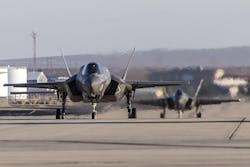Lockheed Martin to develop avionics software that enhances safety by helping F-35 pilots avoid crashes
Officials of the U.S. Naval Air Systems Command at Patuxent River Naval Air Station, Md., announced a $14.1 million order Wednesday to the Lockheed Martin Aeronautics Co. in fort Worth, Texas, to develop the F-35 Automatic Ground Collision Avoidance System (AGCAS), an on-board system that prevents controlled flight into terrain.
Controlled flight into terrain describes flight mishaps that most often result from pilot disorientation or confusion in bad weather or at night that leads to accidental crashes.
Sometimes in challenging visual conditions, pilots mistakenly believe they are flying straight and level, while in reality they are flying towards the ground. In other instances, pilots mistakenly believe they are operating at safe altitudes, while they actually are headed toward mountains or other obstacles.
Pilots can lose touch with their surrounds and become disoriented from factors like target-fixation or losing track of the horizon in the dark in bad weather. Pilots also can black out in tight-G turns. In case of a probable ground collision, the AGCAS would enhance safety by activating, taking control from the pilot, and returning the plane to altitude.
Related: Safety- and security-critical avionics software
It is these kinds of controlled flight into terrain accidents that the AGCAS is designed to prevent. It involves anti-collision software that executes an automatic recovery maneuver when impact with the ground is imminent.
AGCAS compares a predicted trajectory, based on GPS positioning and system altitude, with an onboard digital terrain database. If the program recognizes the aircraft is likely to crash, it prompts the pilot to evade. If the pilot fails to do so, the system takes temporary control and diverts the plane away from the potential crash.
The anti-collision software was developed at the Air Force Research Laboratory at Wright Patterson Air Force Base, Ohio, and became operational on F-16 jet fighters in 2014.
F-35 pilots today have an earlier version called Manual Ground Collision Avoidance System, which warns pilots of imminent crashes, but doesn not take control of the aircraft, if necessary. Sometimes this doesn't help severely disoriented pilots. Now Lockheed Martin experts are ready to carry out a rapid integration process on the F-35 models for the Air Force, Navy, Marine Corps, and international partners.
On this order Lockheed Martin will do the work in Fort Worth, Texas, and should be finished by March 2020. For more information contact Lockheed Martin Aeronautics online at www.lockheedmartin.com, or Naval Air Systems Command at www.navair.navy.mil.
Ready to make a purchase? Search the Military & Aerospace Electronics Buyer's Guide for companies, new products, press releases, and videos
